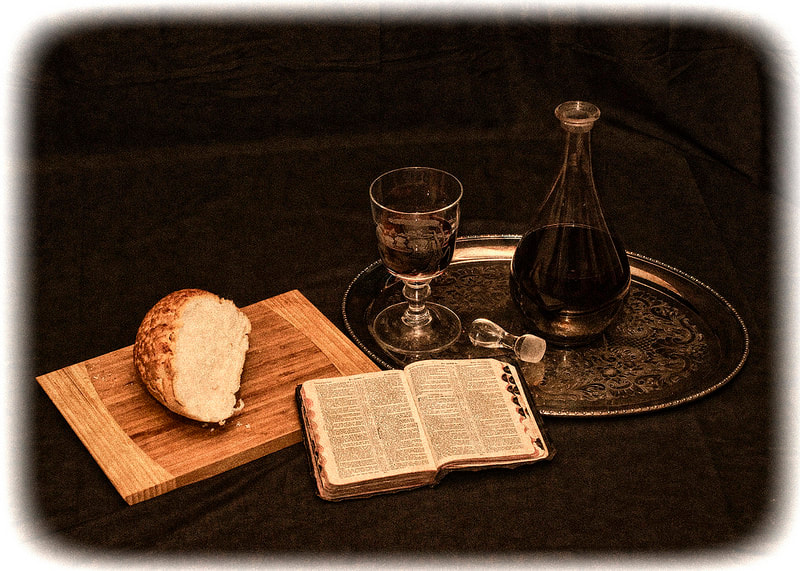|
-Rev Melissa Fain- Whether it's communion, the bible, or a person's life- most heated arguments about God are less about if God enters the picture and more about when and where. The Bible might be a divinely inspired book, but that means something different depending if your Bible is inspired or literal. God is present at Communion, but is it in the symbol or the literal body and blood? You might feel you need an intermediary to connect to God or you can pray directly. Knowing these little pieces of information can help you traverse the spiritual talk with fellow believers who just don't believe the same way you do. If the above paragraph was confusing, I will pull it apart. Let's talk Communion. The Communion Table Tells Us Our TheologyThe truth is, there are many elements of worship that speak to a larger belief system. The better a congregation or denomination is about laying out their beliefs about God and the world, the clearer one can see the meaning and purpose in their actions. Don't confuse this with healthy or good. Just because you step into a tradition that is transparent in their beliefs, doesn't mean they are good beliefs. For example, Ken Ham recently sent his book, Gospel Reset, to churches across the nation. For those who don't know, Ham is a hard-core creationist. His theology begins with a literal creation that took literally six days. He believes in the inerrant (meaning without mistake) and literal Word of God so much he has built a creation museum and Ark Encounter. Both spaces are projects that took millions of dollars. Sending a hardback copy of ones belief system also cost tons of money. Every action he makes is centered on creation. Ham is transparent and connects the dots to all areas of his faith. I personally believe his transparency doesn't make the belief system good, and I believe it's not. That's a post for another day. How a Christian Church traverses the table connects too. Who can serve? Who can partake? Where and when in the worship does it happen? Is it intentional or is it slapped together last minute? What materials are the chalice and patent (cup and plate)? What kind of bread is being used? What liquid is in the cup? Is it grape juice or actual wine? All these questions seek a deeper understanding of the church as a whole. Ken Ham starts at Creation. I start at the Communion Table. Who is Serving?This is a two-part answer that fit most Christian experiences. First, the person preparing, and serving communion could be ordained or not. Being ordained means the person was chosen by the church for a leadership role, usually the minister. This could also be congregants who were chosen for a specific role, like passing out the bread and cup. Who is making the communion available to the congregation is a statement of the sacred responsibility. If only clergy is allowed to meditate and pray over the pieces of communion, than there is a very high and sacred trust given to the clergy. The Catholic Church has a very high trust given to clergy, probably the highest trust of all the Christian faith traditions. The sex abuse scandals are scandalous because it first breaches that sacred trust. It was made worse by others trying to others trying to hide those indiscretions. The Catholic church has dealt with the repercussions of our fallen nature before over 1,000 years ago, but in relationship to being openly christian and baptism. Would the baptisms done by Priests that were not open about being priests, or gave up their books to be burned really baptized. The ultimate answer was yes, but it tore the church apart in the meantime. Secondly, the individuality of the person is an image of God. This idea, the first time I heard it, was offensive to me. I was counselling or co-directing at Church Camp. (Which one is not really relevant right now.) I was quietly discussion the image of Christ with another adult. We were commenting on how different cultures naturally illustrated Jesus to look like them. I was a purist at the time, and felt that was not how God should be depicted. Thank goodness other adult was a minister who knew the zealousness of youth. He patiently told a story where he was with a bunch of elementary school kids at his church. They were asked to draw God. He was shocked to see they were not drawing a guy with a long white beard, but many of the kids were drawing him! He explained to me that they knew and he knew he was not God. What I've come to realize is God shines through the person we have chosen to lead communion. Can we truly understand God until we see the Divine shine through our very neighbor? God Meets UsWhen one partakes of Communion, it is generally believed God is present somewhere in that rite. There are faith traditions, Catholic and Orthodox being the two biggest, that believe the Spirit enters the bread and wine literally transforming it to the Body and Blood of Jesus Christ. You might notice these traditions have high standards to partaking of the elements of Communion. One must be prepared to partake of communion, because the presence of God is always understood to already be there. God is real to the entire community. The opposite faith tradition still has God present in Communion, but the bread and wine (usually grape juice in these traditions) are symbols of Jesus' sacrifice. The Spirit isn't literally imbuing the elements. Instead, the Spirit is with the believer. The act of Communion is still done by the entire community, but the presence of God in that meal happens after the elements leave the table. The Elements of the TableMy favorite church Communion set was completely wood. It was gorgeous. It reminded me God being present in nature. It sat right next to that classic metal cup and plate that is standard fare for most Protestant churches. Once those rich wooden discs were placed was next to it, all imagery was gone, but symbolism wasn't. This was a church that was broken by a large group leaving and starting their own church. Those who stayed behind kept a theology of believing it is right to make it work, instead of letting go of what no longer fits. Understanding where they were, helps us see this is a table in pain.
The table itself and what is physically holding the sacred elements can tell us so much about a church and those who worship within it. If there are sharpie'd circles on the glass overlay to make sure the elements are placed exactly where they belong each Communion, that could be a sign this church holds order very high. If Communion is in a to-go packet (where you peel the top off to get to the elements) it's very possible your church puts ease pretty high on their weekly requirements. |
Categories
All
Archives
October 2023
|




 RSS Feed
RSS Feed